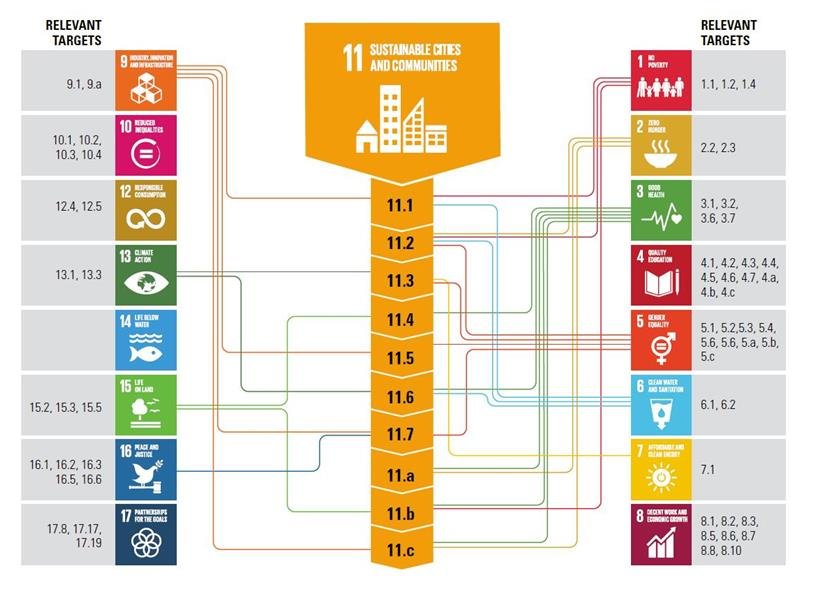- Home
- Relationships between SDG 11 (Sustainable Cities and Communities) and other SDGs
Relationships between SDG 11 (Sustainable Cities and Communities) and other SDGs
Posted On Jun 07, 2025

The 2030 Agenda for Sustainable Development has prominently spotlighted urban areas, positioning Sustainable Development Goal 11 (SDG 11) at the forefront, with the aim of fostering inclusive, safe, resilient, and sustainable cities and human settlements.
This urban-centric focus is not an isolated endeavor but intricately interwoven into the broader fabric of the Agenda, highlighting the intricate interdependencies across various development objectives.
SDG 11, with its holistic approach to urban issues, encompasses a diverse array of aims. These encompass addressing slum conditions, enhancing affordable transportation, curtailing urban sprawl, refining urban governance, preserving cultural heritage, bolstering urban resilience, combating climate change, managing pollution and waste, and ensuring access to secure public spaces.
The goal's ten targets and fifteen indicators, primarily assessed at the city level, underscore the pivotal role of urban areas within the global sustainable development paradigm.
However, SDG 11's significance transcends its immediate urban focus. Its targets and indicators are deeply intertwined with numerous other SDGs, forming a nexus of objectives that collectively tackle the multifaceted aspects of sustainable urbanization.
For instance, endeavors to alleviate poverty and enhance health under Goals 1 and 3 respectively, are intimately connected with the urban context of SDG 11. Likewise, challenges regarding water and sanitation (Goal 6) and clean energy (Goal 7) are integral to the attainment of sustainable urban environments.
These interconnectednesses are not mere happenstance but mirror the inherent intricacy and interdependence of sustainable development challenges. Urban areas, as hubs of economic, social, and environmental activity, stand at the crossroads of these challenges.
Mismanaged urbanization can exacerbate issues such as climate change, energy security, and waste management, which subsequently impact broader objectives such as education, gender equality, and good governance, addressed by SDGs 4, 5, and 16, respectively.
The interplay of SDG 11 with other SDGs underscores a fundamental principle of the 2030 Agenda: the challenges of sustainable development are intertwined, and thus the solutions must be as well. The focus on urban areas offers a distinctive perspective through which to perceive and tackle these challenges, transforming cities from mere settings for sustainable development into active, dynamic agents in the pursuit of these global objectives.
Below All the Relation with SDG 11:
SDG 1 (No Poverty):
Sustainable cities can offer economic opportunities, affordable housing, and social services, contributing to poverty eradication.
SDG 2 (Zero Hunger):
Urban agriculture initiatives in sustainable cities can help promote food security and reduce hunger among urban populations.
SDG 3 (Good Health and Well-being):
Access to clean water, sanitation, healthcare, and green spaces in cities can improve public health and well-being.
SDG 4 (Quality Education):
Accessible and inclusive education systems in cities can ensure that all residents have opportunities for learning and skill development.
SDG 5 (Gender Equality):
Gender-responsive urban planning can address the specific needs and challenges faced by women and girls in cities, promoting gender equality.
SDG 6 (Clean Water and Sanitation):
Sustainable cities prioritize access to clean and safe drinking water, as well as improved sanitation systems for all residents.
SDG 7 (Affordable and Clean Energy):
Sustainable cities invest in renewable energy sources, energy efficiency measures, and sustainable transportation systems to reduce greenhouse gas emissions and promote clean energy access.
SDG 8 (Decent Work and Economic Growth):
Sustainable cities can create employment opportunities, promote entrepreneurship, and foster economic growth through infrastructure development and innovation.
SDG 9 (Industry, Innovation, and Infrastructure):
Sustainable urban infrastructure, including transportation networks, communication systems, and resilient buildings, supports economic development and innovation.
SDG 10 (Reduced Inequality):
Inclusive urban planning and policies can reduce inequalities within cities by ensuring equitable access to resources, services, and opportunities for all residents.
SDG 12 (Responsible Consumption and Production):
Sustainable cities promote resource efficiency, waste reduction, recycling, and sustainable consumption patterns among urban populations.
SDG 13 (Climate Action):
Sustainable urban planning and resilient infrastructure can help mitigate climate change impacts and reduce greenhouse gas emissions in cities.
SDG 14 (Life Below Water):
Sustainable cities can contribute to the conservation and protection of marine and coastal ecosystems through responsible waste management and pollution prevention.
SDG 15 (Life on Land):
Sustainable urban development practices can help preserve terrestrial ecosystems, protect biodiversity, and promote sustainable land use within and around cities.
SDG 16 (Peace, Justice, and Strong Institutions):
Safe, inclusive, and sustainable cities are essential for promoting peaceful and inclusive societies, as well as ensuring access to justice and effective governance.
SDG 17 (Partnerships for the Goals):
Collaborative partnerships between local governments, businesses, civil society, and other stakeholders are crucial for achieving sustainable urban development and SDG 11 targets.

